TileLetter is bringing you a new feature that distills the wisdom of select twice-monthly webinars with industry experts hosted online by NTCA. Want to attend a webinar in the future? Visit www.tile-assn.com/page/ntca-webinars and see what’s coming up on the agenda. — Ed.

Patrick Neaton, a seasoned expert with 17 years in the electric radiant floor heating industry, currently serves as the product manager for the heating and lighting cluster at Schluter Systems. He oversees the DITRA HEAT and LIPROTEK product portfolios. In a recent NTCA Webinar, Neaton delved into the distinctions between radiant and convective heat, the benefits of in-floor heating in tiled installations, and scenarios where electric in-floor heating can reduce reliance on other heat sources. He also discussed factors that influence a room’s temperature regulation.
Understanding radiant heat
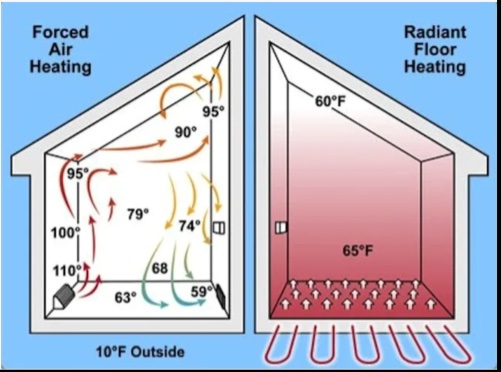

Radiant heat works by transferring heat energy from a warm surface to a cooler one via electromagnetic waves. For example, if you place an ice cube on a hot sidewalk, the heat from the sidewalk melts the ice, illustrating how radiant energy transfers from a warmer to a cooler surface.
Comparing the temperature distribution of forced air from baseboard vents to that of radiant floor heating reveals significant differences. Convection heating often results in uneven temperature distribution, but radiant floor heating provides consistent temperature at head level, ensuring ideal thermal comfort. Thermal comfort is achieved when the rate at which our bodies release heat matches the rate at which it is produced. If the release rate is too low, one feels uncomfortably hot; if too high, uncomfortably cold. Radiant heat, therefore, is optimal for maintaining comfortable conditions within a room.
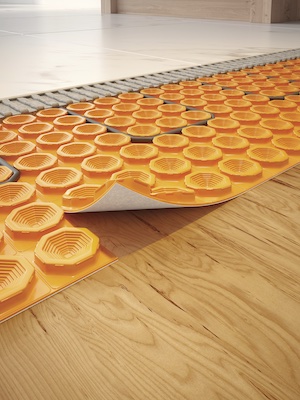

Advantages of heated tile and stone floors
Electric floor heating offers several benefits, particularly when used with tile and stone floors:
- Radiant floor heating produces uniform heat, making the room comfortable and cozy.
- It is highly efficient in energy use, translating to cost savings.
- It reduces the reliance on fossil fuels, aligning with sustainable energy practices, such as using clean power from wind, solar, or hydroelectric sources.
- Unlike convection heating, radiant heating doesn’t circulate dust, germs, or allergens, and helps maintain optimal humidity levels, which are crucial for preventing bacteria, viruses, fungus, and dust mites.
Tile and stone are particularly effective for radiant heating due to their low thermal resistance, allowing heat to pass through efficiently and warm the occupants above. Moreover, electric floor heat systems are environmentally friendly because they reduce the need for conventional heating methods, lowering the dependency on fossil fuels.
Additional benefits of in-home radiant floor heat systems
Radiant floor heating systems offer silent and invisible solutions by being installed beneath the finished floor. They eliminate the need for ductwork, boilers, valves, or other equipment. They provide comfort at lower air temperatures by heating from the ground up, reducing or eliminating air temperature stratification.
Another significant advantage is the creation of thermal mass when a tiled floor is heated. This mass stores heat, which can be beneficial for limiting energy use during peak demand hours when electricity is more expensive. As a result, energy consumption is reduced, leading to cost savings. The stored heat continues to radiate warmth, even during peak hours, ensuring comfort. When the peak period ends, the heating system can be reactivated during cheaper off-peak hours, maintaining efficiency and cost-effectiveness.
Electrically-heated tiled floors offer a range of benefits, including consistent comfort, energy efficiency, environmental friendliness, and health advantages. They provide an effective and modern solution for home heating, aligning with sustainable practices and reducing overall energy costs.
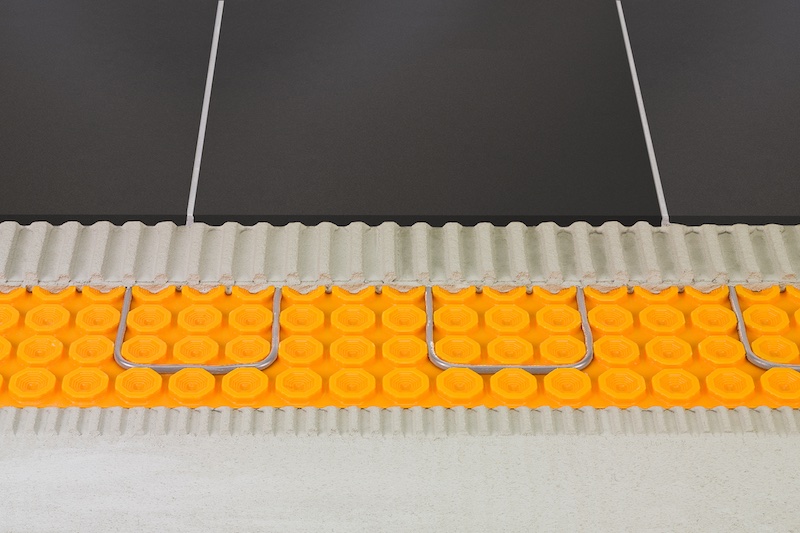

Exploring secondary stage heating with electric radiant floors
Secondary stage heating combines electric radiant floor heating with baseboard heaters to enhance overall room warmth. This approach leverages existing heat sources like baseboard heaters, which can be connected to the same thermostat as the in-floor heating system through a relay.
The baseboard heater raises the ambient air temperature to the desired set point, while the in-floor heating cable warms the tile. Once the floor reaches the set temperature, the power to the in-floor cable turns off. The baseboard heater continues operating until the room’s ambient temperature meets the set point, prioritizing the warmth on the floor.
This method allows for a comfortable and customizable heating experience. For instance, if you prefer to maintain the floor temperature at a comfortable 80 degrees instead of 90 degrees, activating the baseboard heater can help achieve the desired ambient temperature without overheating the floor.
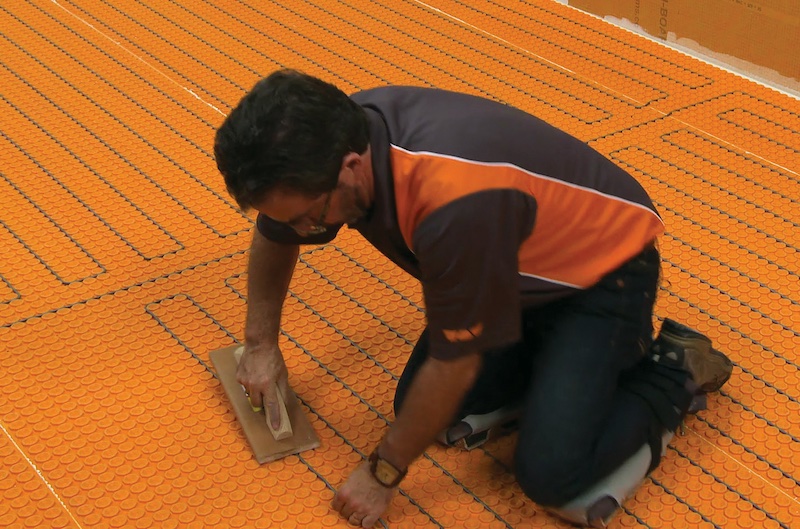

Can electric radiant floor heat be used for space heating?
In remodeled scenarios considering various heat sources, electric radiant heat can be evaluated as a primary heat source. However, determining its effectiveness requires thorough homework and consultation with a heating expert. Given the diverse climate regions across the U.S., local expertise is essential to assess the heating needs accurately.
Factors impacting space heating: Several factors influence the effectiveness of electric radiant floor heating systems:
- The quality and quantity of windows impact heat retention
- The size and height of the room affect heating efficiency
- The type of subfloor material can alter the system’s performance
- Different climate zones have varying heating requirements
- Older buildings may have different insulation needs
Consulting with local experts: Schluter Systems recommends consulting with local heating experts to determine the BTU requirements for your project. Local experts can provide tailored advice based on the unique characteristics of your space, ensuring optimal heating performance.
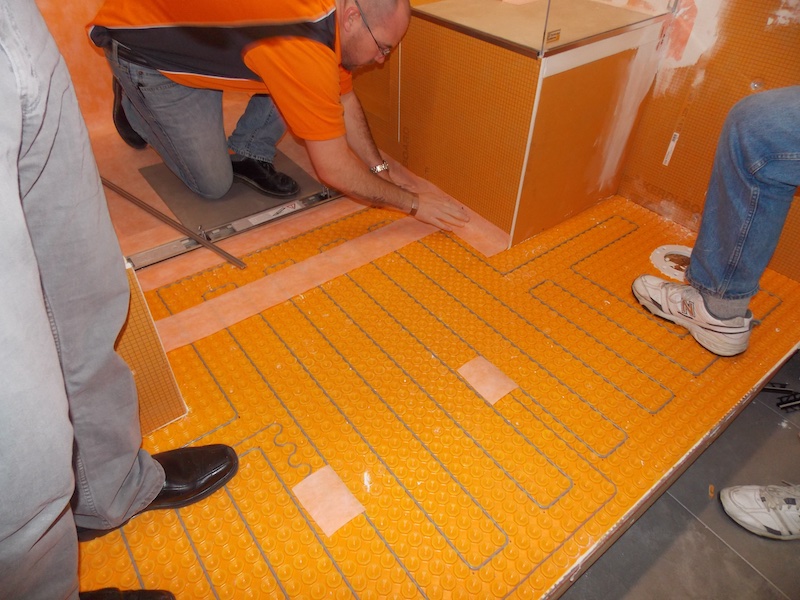

Performance of electric radiant floor heating systems
Electric radiant floor heating systems typically produce between 42 to 45 BTUs per square foot. This range is consistent across industry standards. Additionally, underlayments like uncoupling membranes can enhance system performance by securing the heating cable and improving response times.
For example, using a membrane with a thermal break beneath the tile can significantly reduce warm-up times, particularly over concrete substrates. This results in faster heat delivery and increased energy efficiency.
Key takeaways
- Electric radiant floor heating is efficient and can reduce reliance on other heat sources.
- The system provides even heat distribution, improving comfort.
- Radiant heating reduces the circulation of dust and allergens, maintaining optimal humidity levels.
- Consulting with local heating experts ensures the system meets specific space heating requirements.
By combining electric radiant floor heating with baseboard heaters, you can achieve a versatile and effective heating solution tailored to your home’s unique needs. Proper planning and expert consultation are crucial to maximizing the benefits of this integrated approach.


Elena Grant
Elena Grant is the Assistant Executive Director of Marketing, Communications and Public Relations for the National Tile Contractors Association and Publisher of its publication TileLetter. Grant has over 20 years of experience leading marketing initiatives, programs, and operational enhancement strategies. As Publisher of TileLetter, she oversees all print and digital communications for the publication.





